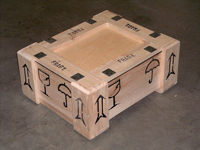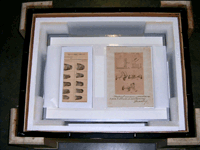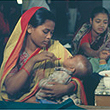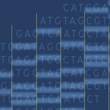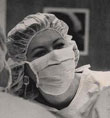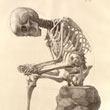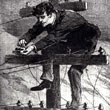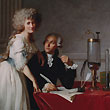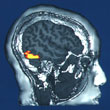Notes on a Loan
Notes on a Loan
Exhibitions are filled with many interesting and historical objects that help illustrate the stories being told. The exhibition registrar is the individual who works behind the scenes to safely bring these objects to the museum or library for display. The registrar prepares loan documents; arranges packing, shipping, and customs; and oversees the mounting and installation of objects.
The National Library of Medicine borrows objects from a wide variety of sources. This acquisition process can present both easy and complex challenges beginning with the selection of an object by the curator to the final display of the object in the exhibition. One particularly interesting case is the loan of several objects from the Museo Policial (Police Museum) in La Plata, Argentina for the exhibition Visible Proofs: Forensic Views of the Body. Let's look at the registrar’s files and see how this loan evolved.
early October 2003
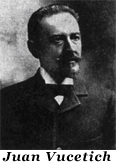 The curator has decided to include the Juan Vucetich story in the exhibition and he's trying to locate photographs and objects we can use. It will be a great story that highlights the development of a fingerprint identification system in Argentina where it was used for the first time to solve a murder.
The curator has decided to include the Juan Vucetich story in the exhibition and he's trying to locate photographs and objects we can use. It will be a great story that highlights the development of a fingerprint identification system in Argentina where it was used for the first time to solve a murder.late October 2003
The curator has located some objects and phographs for the story. They are at the Museo Policial in La Plata, Argentina not far from Buenos Aires.
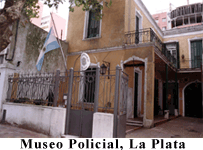
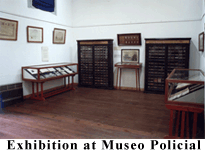
Never having borrowed objects from a small museum in Argentina, I think we ought to get an early start on negotiating a loan in case there's some red tape.
December 2003
It looks like we have an Argentine researcher who has agreed to assist us with this loan. He is based in Buenos Aires and is willing to go to the Museo Policial in La Plata to talk with the director about our interest in borrowing some materials for the exhibition.
early March 2004
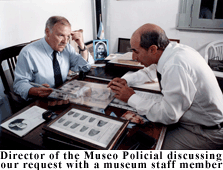 Just received an email from our researcher. He tells us that the director of the Museo Policial is very excited about working with anyone who has an interest in Juan Vucetich's work and legacy. The director says that his is a small museum in a gigantic ministry and their autonomy is limited. When our researcher asked the director about the possibility of the Library borrowing materials, the director told him that although he was excited about the National Library of Medicine's project, he didn't think the loan would be possible since the Ministry of Security (a government agency), which has jurisdiction over the Museo Policial, rarely authorizes the loan of materials. I guess this is what our Argentine researcher calls “an example of the complex bureaucratic ways we will be facing.”
Just received an email from our researcher. He tells us that the director of the Museo Policial is very excited about working with anyone who has an interest in Juan Vucetich's work and legacy. The director says that his is a small museum in a gigantic ministry and their autonomy is limited. When our researcher asked the director about the possibility of the Library borrowing materials, the director told him that although he was excited about the National Library of Medicine's project, he didn't think the loan would be possible since the Ministry of Security (a government agency), which has jurisdiction over the Museo Policial, rarely authorizes the loan of materials. I guess this is what our Argentine researcher calls “an example of the complex bureaucratic ways we will be facing.”later in March 2004
Our exhibition coordinator here in Bethesda continues to work on getting our Argentine researcher “in our system.” She's written the contract, defined the plan for his activities, and has almost gotten him into the accounting system, so he can get paid. Meanwhile, a colleague put me in touch with a registrar from Argentina who lives in the United States. She'll help us with communications and translations which should make processing the paperwork and making arrangements in Argentina a lot easier. I think she'll be a good person to consult on this project since she’s worked in a museum in Argentina and understands the bureaucracy.
later still in March 2004
 Today, I telephoned an international shipper with whom we've previously worked to get some shipping and customs estimates. Since this loan is coming from Argentina, we will need an international customs broker who can facilitate customs clearance upon arrival in the United States. I should hear back from the shipper in the next few weeks. I also need to call our insurance broker to negotiate the insurance coverage we'll need for the international shipment.
Today, I telephoned an international shipper with whom we've previously worked to get some shipping and customs estimates. Since this loan is coming from Argentina, we will need an international customs broker who can facilitate customs clearance upon arrival in the United States. I should hear back from the shipper in the next few weeks. I also need to call our insurance broker to negotiate the insurance coverage we'll need for the international shipment.May 2004
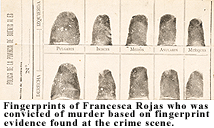 Sent out a copy of the National Library of Medicine's loan form to our consulting registrar for translation. As soon as she returns it, I can send
it off to our researcher working in Argentina, so he can give the director of the Museo Policial a more formal introduction to our request.
Sent out a copy of the National Library of Medicine's loan form to our consulting registrar for translation. As soon as she returns it, I can send
it off to our researcher working in Argentina, so he can give the director of the Museo Policial a more formal introduction to our request.later in May 2004
Just heard back from our researcher in Argentina. He received positive feedback from the director of the Museo Policial. I guess it's time to send our official loan request to the minister of security who will make the final decision on whether to authorize the loan.
early June 2004
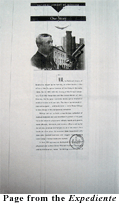
 The loan request has arrived in Argentina and is now on the desk of the minister of security in La Plata. It's being compiled by the government officials into a document they call the Expediente. This is the official Argentine loan document that will circulate among the government offices for review, and hopefully approval. There are all sorts of materials in the Expediente that support our request for this loan. The Expediente includes the Argentine government rulings about museums, information about the National Library of Medicine and our exhibition which have been translated into Spanish, as well as letters of support from other government officials in Argentina. Now it's a matter of waiting for a number to be assigned to the Expediente, which will be used used to track our loan request. Once the Expediente has a number, then we'll know it's on its way.
The loan request has arrived in Argentina and is now on the desk of the minister of security in La Plata. It's being compiled by the government officials into a document they call the Expediente. This is the official Argentine loan document that will circulate among the government offices for review, and hopefully approval. There are all sorts of materials in the Expediente that support our request for this loan. The Expediente includes the Argentine government rulings about museums, information about the National Library of Medicine and our exhibition which have been translated into Spanish, as well as letters of support from other government officials in Argentina. Now it's a matter of waiting for a number to be assigned to the Expediente, which will be used used to track our loan request. Once the Expediente has a number, then we'll know it's on its way.late June 2004
We've just heard from Argentina that a number has not yet been assigned to the Expediente. Our researcher in Buenos Aries reminds me that “it can take hours, weeks, months to get an answer as we have entered into the bureaucracy.” Sounds like it's going to be a long process. I'm glad we started early.
very end of June 2004
A number has finally been assigned to the Expediente.

Yeah! Now the journey really begins.July 2004
Heard from our researcher today. He tells me that the Expediente has gone to the technical administrator in the Ministry of Security for review. I understand that his approval is crucial in recommending the loan to the Minister of Security.
September 2004
The technical administrator has approved the Expediente! Although he works in the Ministry of Security, it is the minister himself who has the final say so for our loan and there are still quite a few steps to go before the minister will review our paperwork. Nevertheless, it looks like we made it past the first government office. Now the Expediente is going from the technical administrator's office to the Secretary of Culture for the Province of Buenos Aires and then to the Ministry of Security’s legal advisor.
later in September 2004
Just heard from our researcher. The Expendiente made it past the Secretary of Culture and was reviewed by the legal advisor in the Ministry of Security who prepared a positive report. Our researcher tells me that even though the report was positive, the Expediente still needs to go to another government office for approval before it reaches the minister of security.
later still in September 2004
Well, the Expediente went back to the technical administrator's office today. He'll be forwarding the paperwork to the Office of Historic Patrimony and Ministry of Education for review.
October 2004
 The Ministry of Education has reviewed the Expediente and gave their 'okay.' Now the paperwork is going back to the Ministry of Security. We're still working on the customs and shipping logistics on our end. I've received the shipping estimates and I've started the process of insurance coverage. The exhibition coordinator is still working on getting our researcher paid—since March 2004! Seems like we have our own bureaucracy. Nevertheless, things seem to be moving along.
The Ministry of Education has reviewed the Expediente and gave their 'okay.' Now the paperwork is going back to the Ministry of Security. We're still working on the customs and shipping logistics on our end. I've received the shipping estimates and I've started the process of insurance coverage. The exhibition coordinator is still working on getting our researcher paid—since March 2004! Seems like we have our own bureaucracy. Nevertheless, things seem to be moving along.November 2004
Looks like the Expediente is still working its way through the bureaucracy in La Plata. I just found out that it was sent by the Ministry of Security to the General Advisor of the government for review and is now with the Office of Cultural Patrimony of the Nation, which is another agency of the Buenos Aires government.
December 2004
Heard from our researcher today. He reminded me that although no one in Argentina is saying no to the loan, the Expediente always needs another step before it reaches the Minister of Security's hands for the final decision. It's quite a complicated process.
later in December 2004
Guess what? After six months of traveling from one government official's office to another, the Expediente has finally reached the office of the minister of security—the ultimate authority. Now we just have to wait for his review and approval. We're keeping our finger(prints) crossed.
early February 2005
After three long months, we finally received word that the Minister of Security has signed the legal authorization so that the prized Vucetich objects that are part of the collections of the Museo Policial in La Plata can come to the National Library of Medicine for our exhibition. As our researcher puts it, “Victory is almost there, but not yet. The now infamous Expediente is going back to Buenos Aires to the National Government.” Looks like there are a few more government offices that need to approve the shipping arrangements before the objects can be picked up at the museum.
later in February 2005
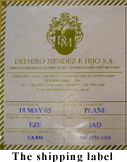 The Expediente has gone to the National Office of Patrimony and Museums and the Secretary of Culture for review. The director of Visual Arts in the National Office of Patrimony and Museums will be preparing the paperwork that will allow the objects to leave Argentina.
The Expediente has gone to the National Office of Patrimony and Museums and the Secretary of Culture for review. The director of Visual Arts in the National Office of Patrimony and Museums will be preparing the paperwork that will allow the objects to leave Argentina.We've engaged the services of a shipper in Argentina who will be handling all of the transportation, crating and customs in Argentina. He'll be working with the director of Visual Arts in the National Office of Patrimony and Museums to finalize the arrangements.
later still in February 2005
Our customs broker here in Washington is finalizing the documents that we need to bring the Vucetich objects into the United States. I've put together a detailed itinerary for the insurance company that lets them know where the objects will be at all times, from when they're picked up at the museum until they reach us here at the library. They should be able to get the insurance coverage started as soon as they process this information.
March 2005
The shipper in Argentina just let me know that they received the approved documents from the government, so they can now begin the arrangements to pick up the objects and get them ready for crating. I told him that I would let him know when the signed loan agreement arrives, so that they can physically pick up the objects at the museum. It won't be long now.
April 2005
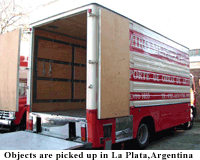 The signed loan agreement finally arrived from Argentina. After nearly a year and a half, it looks like there really is some light at the end of the tunnel. I've contacted our shipper and let him know that they can now officially pick up the objects at the museum and prepare them for shipping.
The signed loan agreement finally arrived from Argentina. After nearly a year and a half, it looks like there really is some light at the end of the tunnel. I've contacted our shipper and let him know that they can now officially pick up the objects at the museum and prepare them for shipping.early May 2005
The objects have been picked-up at the Museo Policial in La Plata. Our shipper brought the objects to their facility for packing and crating. The objects are now officially under the protection of the National Library of Medicine.
May 18, 2005
After 30 months of email exchanges, faxed forms, filled out paperwork, phone calls, and ever patient waiting, the Vucetich objects are finally on their way to the United States. They were loaded onto flight 86 from Buenos Aires today and they should be arriving at Dulles International Airport in Virginia (just outside of Washington D.C.) early tomorrow morning.
May 19, 2005
They’re here! The objects just arrived from the airport. The crate was delivered by a fine arts shipper and arrived at the National Library of Medicine loading dock in an air-ride suspension, climate controlled, exclusive-use truck all by itself. It's hard to believe that after all this time, we received one small crate in the back of a truck. I realized today that the Vucetich objects traveled 5,218 miles from Buenos Aires to Washington, D.C. and took at least 25 people working in both Argentina and the United States to make this loan happen. It will be great to have these original documents in the exhibition.
February 16, 2006
Visible Proofs: Forensic Views of the Body opened today to an enthusiastic reception. This whole process of securing this loan from Argentina has been an incredible adventure! The objects look great. I'm excited to have been able to meet the challenge—an international loan of unique historical materials held by a government institution—and to find so many helpful and cooperative people along the way who were willing to make this loan a reality.
The Vucetich story is one with which most audiences in the United States are not familiar. Our exhibition will be able to introduce people to another aspect of history and give them a chance to see the objects that remain as evidence of that history. This adventure has been a professionally rewarding experience for me and I hope our visitors will find the objects interesting and meaningful.




